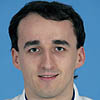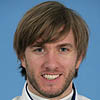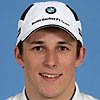


20/01/2009
NEWS STORY
 How far will driving in Formula One change in the 2009 season compared to 2008?
How far will driving in Formula One change in the 2009 season compared to 2008?
Robert Kubica: Aerodynamics will be reduced by around 40 or 50 percent, so the downforce level of the cars will be much lower. Taking this into account, Formula One will be influenced much more mechanically than aerodynamically. Nevertheless, aerodynamics will still play a big role. I expect quite big differences between the cars – especially at the beginning of the season. The return of slick tyres is one of the best things to happen in Formula One in the last five or six years. I guess that all drivers prefer slicks to grooved tyres and are pretty happy. Finally, the introduction of KERS is a major change. However, at the moment it is hard to predict how much it will affect driving.
What are the attributes/characteristics a good Formula One driver needs?
RK: First of all performance – you have to be quick. Additionally, understanding the technical side of the sport and being able to give good feedback to the engineers. Also, the driver's experience and the way he works with the team are important. There are many factors that make a good Formula One driver. However, if I have to choose one attribute, it is definitely performance.
Away from Formula One you like to play poker and snooker and go bowling. How do they compare with F1?
RK: They don't compare with Formula One at all. That's why I like them. In my job, I spend a lot of time with a lot of action, high speed and noise. By contrast, poker and bowling are quite steady. You don't have to put in too much effort. Especially when I am bowling I can completely switch off my brain and relax. During the winter break I took part in some tournaments. I have some friends who play at a very high level in Europe. I really enjoy playing with them.
How do you deal with set-backs?
RK: Losing is part of life. You have to take the positive aspects from winning and the positive aspects from losing. Set-backs can make you much stronger. Actually, you can profit much more from losing than from winning. The years in my life I learnt most were the years when I was not able to achieve my goals. During these times I became a lot stronger. Of course, I enjoy the times when everything is running smoothly. But life is always changing – sooner or later you will have to deal with difficulties again. It is important to conquer these difficulties in the right mood and to learn from them.
 How important is talent in F1, and how much of the driver's art can be learnt?
How important is talent in F1, and how much of the driver's art can be learnt?
Nick Heidfeld: Talent, to me, means good instincts, good vehicle control, enjoying what you're doing and, last but not least, being very fast. Those aren't things you can learn, and to that extent talent is the most important thing a driver needs. But you still have to put a lot of work in to get the best out of yourself. Data recording now covers pretty much everything and it can teach you a lot. But interpreting the data and drawing the right conclusions takes time and concentration.
What's the most important thing you learnt in 2008?
NH: That it pays to keep a cool head in any situation.
What difference do you expect the reintroduction of slicks to make?
NH: In previous years I've always said that slicks were the first change I would like to see. So I'm happy to see them come back. F1 cars belong on slicks. They look better too. I never liked the idea of making compromises at the one and only interface between the power and capabilities of a Formula One car and the track surface. I think slicks will help my driving style. Then again, Formula One cars, particularly with the forthcoming changes, are extremely complex, and so are tyres. So I can't really say anything for sure until we've got some experience under our belts with the F1.09 and have measured ourselves against the competition.
How far do you think you and the team can go in 2009?
NH: It's been impressive the way we achieved our goals in 2006, 2007 and 2008. Normally I would say we would be sure to do it again in 2009, and be in with a fighting chance of winning the title. But all the new rules for next season could potentially create a whole new ballgame. I very much hope, though, that we'll put in a strong performance.
Your own personal fleet of cars is growing. What models do you own?
NH: I've got a BMW M3, which I really enjoy driving, and an X5, which we can also pack the children and the dog into. The X5 is not just very spacious, it's also ideal in the Swiss mountains, where we often have snow. Patricia is still driving a MINI Cooper S. We've also got some classics, like a 1967 Beetle convertible. I'm extremely fond of that car. My mother has always driven a Beetle convertible, and still does. To my mind the whole sound, and the memories it brings back, make it the best convertible in the world. I also like the styling of the Ford Mustang – I own a 1965 fastback. There's a 1966 Fiat 500 in our garage as well.
No sports cars?
NH: Oh yes. But if I say I've got a Ferrari, a Porsche or a Lotus, people think I'm boasting. And that's not my thing.
Do you ever feel afraid?
NH: On the race track I'm hardly ever afraid – except if I'm involved in a spin or an accident and waiting for the impact. Obviously that's a moment when you do feel scared. Otherwise, when I think back to my childhood, everybody used to say I didn't know the meaning of the word fear. If there was something to climb or something else to get up to, there was no holding me back.
 Was Formula One your childhood dream?
Was Formula One your childhood dream?
Christian Klien: As a child, I was involved in all sorts of sports. Football, skiing ... whatever was on offer in the Vorarlberg, I did it. As far as motor sport was concerned, I was about eight years old when things really clicked. In 1991 I met my great role model Ayrton Senna. My father and I had slipped into the paddock through a hole in the fence. We were hardly inside before I ran straight into Senna. I was wearing a Harley Davidson T-shirt and a Salzburgring baseball cap. Ayrton spontaneously came over and asked my father to take a photo of the two of us. He was very patient and seemed to know that was what we wanted, even though we would never have dared to ask. That was a moment that pointed me in a whole new direction. From then on I was a committed motor sport fan and soon took up karting. I've still got the photo of Ayrton Senna and me up on the wall at home, taking pride of place.
How did you get from there into Formula One?
CK: We were completely clueless to begin with – not like your typical motor sport family. In any case, originally we saw it more as a pastime than anything else. The whole family came along to kart races in the caravan, and we ended up travelling all over central Europe. My mother cooked, my sister played with other girls and my father in those days acted as mechanic and team owner in one. Everywhere there were the professionals, with their motorhomes and hugely expensive equipment. And then there was us – the tinkerers. To me it was all pretty much of a game, though when I kept on picking up trophies, it became clear not everybody saw it that way. From that time on one thing was clear: now I had found something I actually seemed to be good at – and that was also loads of fun. Robert Kubica and his family were in the same boat as us, incidentally – tinkerers that other folk tended to make fun of.
Can anyone be a Formula One driver nowadays, provided they get the right training?
CK: There are two things every driver needs: talent and the right support at the right time. If there's no talent there, then all the support in the world will be pointless. On the other hand, there have been many drivers in the past who had the talent but got the wrong support, or no support at all – and so they never made it anywhere near Formula One. I spent a number of years in the Red Bull driver development programme, where the pressure was enormous. In the end I was the first driver this programme launched into Formula One. I will always be grateful to Red Bull for that. Even though we later went our separate ways, I still have an excellent relationship with the key people at Red Bull. Now I have a new home though, with the BMW Sauber F1 team. I feel fully integrated here and it's good to be able to contribute my experience.
What's your relationship with your team colleagues?
CK: As I said, I've known Robert since our karting days. We competed against each other many times, and that carried on later into Formula Renault and Formula 3. He was always very fast. We have a lot of respect for each other – though in my spare time I'm no poker ace like him, but tend to go in for proper sport, like skiing in the Arlberg. Nick of course has been in the game a lot longer. He was already testing for Formula One when Robert and I were still karting. But we work together very professionally and he has huge experience.
Has Formula One changed your life?
CK: I always try to keep both feet on the ground. People from the Vorarlberg have a reputation for being very down-to-earth and industrious, so "fame" was never a problem for me. When I started out in Formula One, it was a bit of a shock to begin with to have total strangers recognise you and come up to you in the street. Plus it came just a few weeks after giving up my job as a sheet metal worker, so it was all pretty sudden. The main change was in my lifestyle: one moment I was going to work by moped, then the next, and ever since, I was spending hundreds of hours travelling to work – here, there and everywhere – by air. The important thing is to stay the same person. I hope I've been able to do that.
Do you ever feel afraid?
CK: Not in the cockpit, not really. Otherwise I couldn't do this job. I just sometimes have an uneasy feeling if there's something I find I'm not in control of. As a child, I was really afraid of rollercoasters. You still won't get me on one even today. Being a helpless passenger on something like that – no thanks!
What was the maddest thing you've ever done?
CK: Actually it was something on exactly those lines. In Budapest, Hannes Arch talked me into going up with him as a passenger in his two-seater stunt plane. That was pretty extreme. As a racing driver you're used to g-forces, but looping the loop head down a few metres above the Danube was a whole different ballgame. The main thing was I held on to my breakfast. That's something Formula One drivers don't always manage to do.